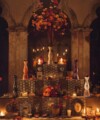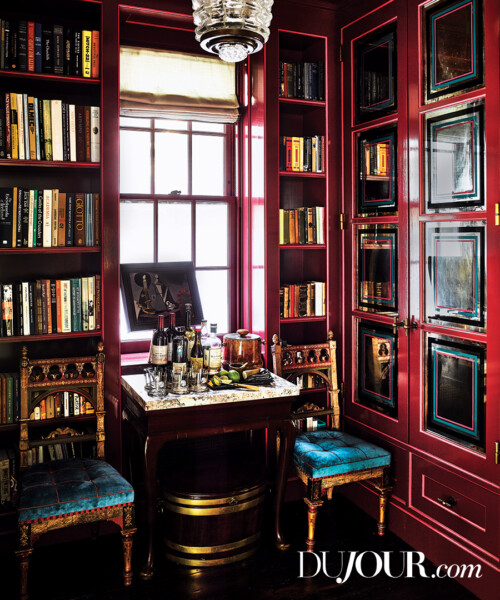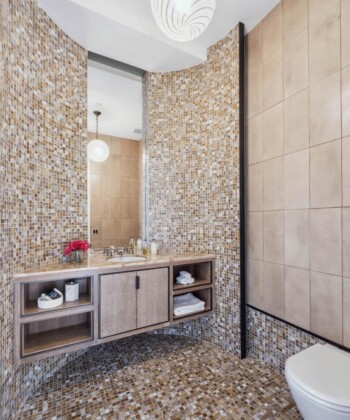There’s something about the unmistakable charm of Manhattan’s West Village. Its distinct character. Rows of picturesque brownstones and townhouses with inviting front stoops that give way to often-quirky layouts. The historic design details and rich heritage that reference a bygone era. When designer Steven Gambrel purchased his home on Morton Street in this highly covetable neighborhood, he fell in love with the property despite its challenges: low ceiling heights, sloping floors, a narrow living room, and an off-center fireplace. In fact, he sought to celebrate those idiosyncrasies and amplify the rich original details of the 19th-century townhouse while redesigning and enhancing the space to accommodate luxe 21st-century living.
Though Gambrel didn’t completely gut the three-bedroom, four-bathroom, 3,500-square-foot property with a Greek Revival brick facade, he did extensive design and construction work to suit exactly how he would live in the home. “I kept all the original parts from the 19th century, then removed the later additions and restored what it was originally. And then I added pieces that I wanted to add,” explains Gambrel, founder and president of New York–based design firm S.R. Gambrel. “The goal was to keep it really authentic and maintain the atmosphere of a historic West Village townhouse—with a twist.”
The first order of business was to demolish and reconstruct the kitchen on the garden level. “I lowered the floor in the kitchen and completely reinvented that elevation,” Gambrel says. “The ceiling height wasn’t adequate for what I wanted to do, so I dug the basement out deeper solely for mechanicals. Then I took advantage of the ceiling height of what was there and lowered the joists in steel. Essentially, I built that new space within the old structure.”
The result yielded a magnificent open chef’s kitchen and dining space with a marble-slab stone floor and marble island that Gambrel constructed, plus custom-built solid-wood cabinetry and top-of-the-line appliances, including a custom-painted Lacanche seven-burner, double-oven range with a custom-fabricated hood; a Sub-Zero refrigerator; and a Miele dishwasher. French doors lead out to a garden, and the cozy dining area is complete with a wood-burning fireplace—one of five that were meticulously restored in this residence.
To maintain the character of the townhouse, Gambrel retained the original floors and preserved a staircase that cuts through the core of the space and is topped with a skylight. Double mahogany doors on the parlor level separate the entry foyer, with its adjacent library/cloakroom, from the floor-through living room, which is 26 feet long but slender. “The living room is pretty narrow,” Gambrel admits. “So the furniture plan had to be really considered. I wanted a lot of seating, and the fireplace is off-center, so that actually adds to the challenge.”
Overall, Gambrel says, the project is an exercise in maintaining “a collector’s house where you entertain the style of great found objects and art.” Gambrel decorated the home with 20th-century art, much of it from the Dutch New Hague School, complemented with midcentury pieces from France, England, and America. And he melds eclectic vintage and antique items from the 18th through mid-20th centuries with custom pieces to create a design scheme that’s truly authentic to his own aesthetic and design sensibilities.
To wit, the elaborate master bathroom tells a “masculine story,” according to Gambrel, who attained the stone by handpicking it from a quarry. “I love to find great unusual stones and pair them together,” he says. “I go into quarries and look for different stones and how they are going to speak to each other. I’m always playing with stone compositions.”
In the living room, a super-heavy solid-bronze mirror that Gambrel found in Hudson, New York, hangs above the mantel as a statement piece, while the bolection fireplace was collected in England. As a juxtaposition of old and new, antique club chairs are set atop a custom carpet by Mansour, vintage lighting prevails throughout, and most of the upholstery was designed by Gambrel himself. Carefully curated mantel selections from Gambrel’s international travels express his personality, while other design decisions were made to maintain a period-appropriate aesthetic for the 19th-century property.
“The whole building is meant to be sort of atmospheric. It’s not crisp by any means,” Gambrel says. “And so the colors and materials and the textures are all trying to work with the patina.” He incorporates various materials “so everything has texture,” he says. The walls of the hallway and the stairwell are clad with Venetian plaster, and the blue living room walls are done in an integrated plaster. “Nowhere in this home is there just paint on a wall. It all has texture and works into the grit of the historic building.”
He adds: “I was looking to create a moody atmosphere, and I’m not afraid of color.” The designer employed punches of color in unconventional ways—in the red carpet of the staircase, the red-lacquered walls of the parlor-floor library/cloakroom, the black walls of the upstairs library that’s capped with a ceiling in a reddish limewash finish, and the upholstered walls of the master bedroom in a hue called Dead Salmon. Gambrel says that for the master bedroom, he worked with a palette that he’d never used before but was curious to try. “It relates to the brick of the house, and it’s sort of unexpected. I’m always experimenting with colors that are unusual,” he offers. “It’s a layering of materials. I’m just trying to try to keep it cozy.”
Click through the gallery for an inside look at this beautifully restored townhouse.







































